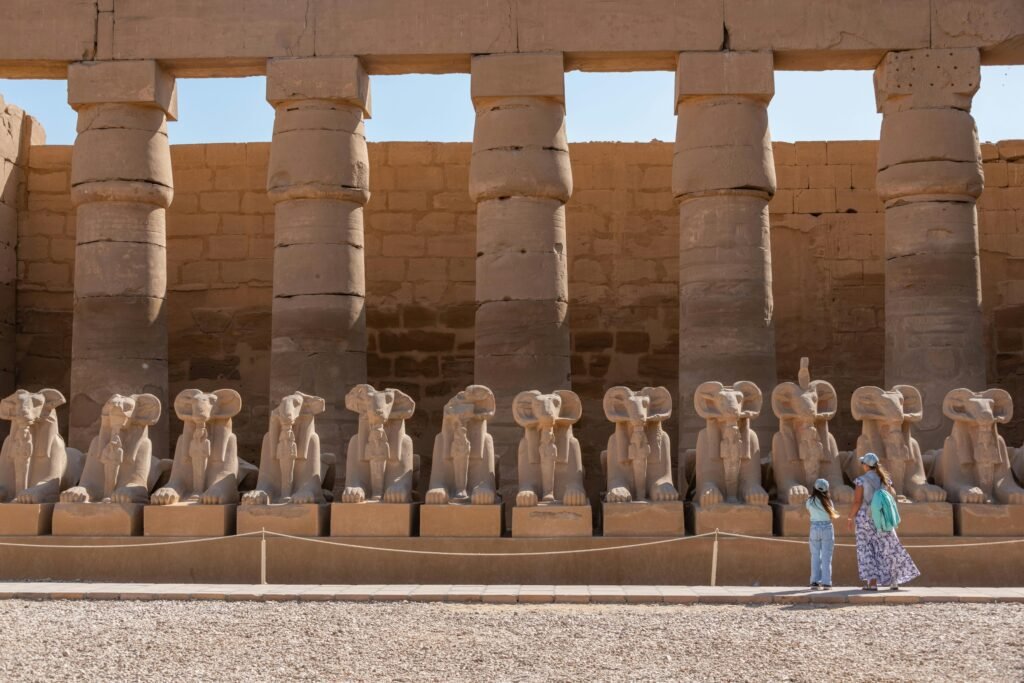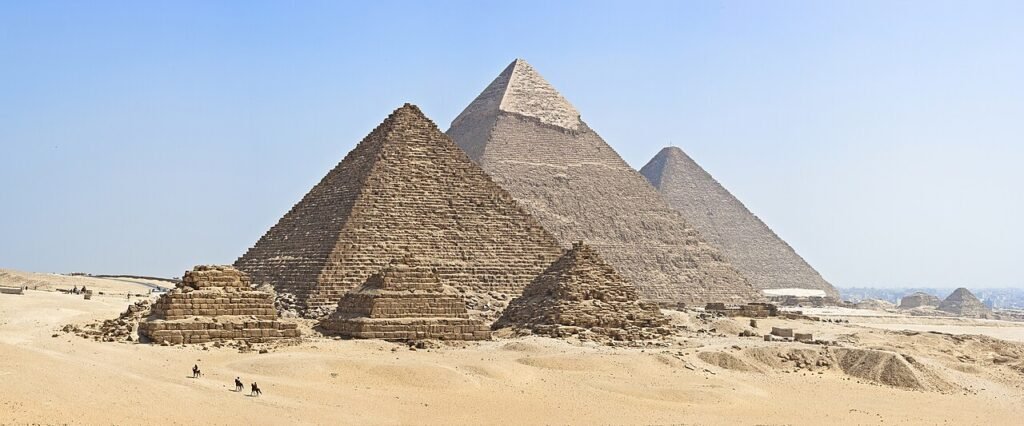
Luxor: Few places compress 4,000 years of human history into one river-bent city quite like Luxor. On the East Bank, colossal columns glow gold at dusk; on the West Bank, a honeycomb of royal tombs sinks into desert hills the colour of baked terracotta. For families, couples, and solo travellers, Luxor is a destination that repays curiosity many times over, easy to navigate, endlessly photogenic, and rich with insight into how ancient civilisations lived, worshipped, ruled and remembered. This guide brings together need-to-know practicalities, deep-cut sights, smart itineraries and UK-centric tie-ins so you can plan a trip that’s as effortless as it is unforgettable.
Why Luxor Captivates
Luxor stands on the site of ancient Thebes, the great city of the New Kingdom pharaohs. Its twin personality ritual and life on the sun-rising East Bank; death and eternity on the sun-setting West Bank still shape how visitors experience the city today. Thebes and its Necropolis are recognised as a UNESCO World Heritage Site, encompassing a dramatic sweep of temples and tombs: Karnak and Luxor Temples, the Valley of the Kings, the Valley of the Queens, Deir el-Bahari, Medinet Habu, Deir el-Medina and more.
A processional road nearly three kilometres long, the Avenue of Sphinxes links Luxor Temple to Karnak, evoking the ancient Opet Festival when sacred barques travelled between the two. That sense of movement endures now: in the gentle drift of feluccas, in pre-dawn hot-air balloons over the West Bank, and in Nile cruises that stitch Luxor to Aswan through fields, palm groves and desert escarpments.
Quick Facts & Planning Snapshot
- Where it is: Upper Egypt, straddling the Nile about 670km south of Cairo.
- Why go: World-class temples and tombs, an approachable city centre, excellent winter sun, easy add-on to Cairo or Aswan.
- Best for: Families (hands-on history, boats, balloons), couples (golden-hour temple visits, resort downtime), solo travellers (walkable East Bank, reliable day tours).
- How long: 2–4 days for highlights; 5–7 days for deeper dives and day trips.
- When to visit: October–April for cooler days and balmy evenings; summers are intensely hot.
- Getting around: Taxis, private guides/drivers, bikes on the West Bank, local ferry/motorboats across the Nile.
- Good to know: Many tombs rotate openings; photography is typically allowed without flash, but special tickets or rules may apply inside certain tombs.
Getting There & Getting Around
Arriving in Luxor
Most UK travellers connect via Cairo for a short domestic flight to Luxor. Another popular route is to fly into Hurghada on the Red Sea and transfer overland to Luxor, handy if you’re pairing temples with reef-time. Independent travellers also use Egypt’s rail network between Cairo and Luxor (including overnight sleepers). Nile cruises often start or finish in Luxor, making the city a natural pivot on a longer itinerary.
Moving About the City
- East ↔ West Bank: Cross on the public ferry (authentic and budget-friendly) or hire a private motorboat from the corniche.
- In town: Central Luxor is compact. You can stroll between Luxor Temple, the corniche, souqs, cafés and museums.
- To sites: The West Bank sprawls; a car with a driver or guided tour is efficient. Confident cyclists enjoy the rural lanes around the tomb sites.
- Taxis & rides: Metered taxis are limited; agree on the fare before setting off. Ride-hailing apps have patchy coverage – ask your hotel to arrange transfers if you prefer.
The Big-Hit Sights (and How to See Them)
East Bank
Karnak Temple Complex
A city of temples within a temple, dominated by the Great Hypostyle Hall, an avenue of stone papyrus columns that swallow you whole. Allow 2–3 hours minimum. Arrive early for soft light and fewer tour groups, or return late afternoon when shadows carve reliefs into high definition. The evening Sound & Light show reframes the site after dark.
Luxor Temple
Intimate by comparison, Luxor Temple sits right in the city’s heart and feels particularly magical at dusk, when its colonnades ignite and the traffic hum outside fades. Don’t miss the colossal seated Ramses II or the chapels reused through successive eras, including Roman and Islamic layers.
Luxor Museum & Mummification Museum
Two compact, well-curated stops that reward an hour each. The main museum’s sculpture gallery is a calm masterclass; the mummification museum is small but illuminating for older children and anyone curious about the science of eternity.
West Bank
Valley of the Kings
The headline act: a desert valley studded with royal tombs dug deep into limestone. A standard ticket admits to a rotating set of tombs; premium tombs (such as Seti I or Tutankhamun) require separate tickets and are superb if you’re keen on polychrome detail. Start as early as possible to beat the heat and queues; electric buggies/trams usually link the entrance to the valley floor.
Temple of Hatshepsut (Deir el-Bahari)
A modernist dream, 3,500 years old. Terraced colonnades notch into cliffs that glow pink in morning light. Combine with the Valley of the Kings on the same morning; the sites lie close together.
Colossi of Memnon
Two weathered sentinels guarding the plains, free to see and good for a quick stop en route to the valleys. Sunrise casts them in cinematic silhouette.
Medinet Habu (Temple of Ramesses III)
Often less crowded than other sites, yet packed with vivid reliefs and towering pylons. If you’re a repeat Egypt visitor or love military history iconography, give this a full hour.
Deir el-Medina (Workers’ Village)
The village of the artisans who carved the royal tombs. Its small tombs are some of the most beautifully painted in Egypt, perfect for families and anyone wanting colour and storytelling at a human scale.
Valley of the Queens (including Nefertari’s Tomb)
Astonishing colour and craftsmanship. Access to the show-stopping Nefertari tomb is limited and controlled; time your visit carefully and expect strict photography rules.
Howard Carter House & Replica Tombs
On the West Bank, Carter’s mud-brick house is now a small museum. Nearby, meticulously recreated replica tombs (including Tutankhamun’s) allow close-up viewing without conserving stress on originals, excellent for children.
Special Experiences You’ll Talk About for Years
- Hot-Air Ballooning at Dawn: Float over fields, villages and tomb-dotted hills as the sun warms the Theban cliffs. Ballooning is weather-dependent and early; build in slack for rescheduling.
- Sailing the Nile: Hire a felucca at sunset for an hour’s glide past palm fronds and sandbanks, or book a dinner cruise if you fancy music and a meal on board.
- Avenue of Sphinxes at Night: The illuminated processional way is a spine-tingling walk post-sunset, especially if you’ve already visited Karnak by day.
- Karnak Sound & Light: Tourist-y? A little. Atmospheric? Absolutely. Consider it if you missed golden hour or want to extend your time among the columns.
- Desert Hikes: Fit travellers can hike the ridge trail linking Deir el-Bahari and the Valley of the Kings with a guide. Views tumble over both banks of the Nile.
Practicalities: Tickets, Rules, Accessibility & Safety
- Tickets & Passes: If you’re planning a high-intensity itinerary, ask about the Luxor Pass, which bundles many East and West Bank sites (a premium version typically includes select “special” tombs). Bring your passport to purchase.
- Opening Hours: Most sites open early morning and close by late afternoon, with seasonal variations and last-entry cut-offs. Plan West Bank visits for the coolest hours.
- Photography: No flash inside tombs; tripods and video usually require extra permits. Some tombs prohibit photography entirely; signage at entrances is the final word.
- Accessibility: Temples typically have broad, flat courts; tombs involve steps and narrow corridors. There are electric buggies at some West Bank complexes and ramps at main East Bank sites. If mobility is a concern, prioritise Luxor Temple, key courts at Karnak and the exterior terraces at Hatshepsut.
- Heat & Hydration: Dress for the sun (hat, breathable clothing, covered shoulders), carry water and electrolytes, and build in shade breaks. Families with young children should favour early starts and midday rests.
- Ramadan & Fridays: Expect shorter hours for some services and a different rhythm to the day; plan temple visits in the morning.
- Animal Welfare: If you choose a horse-drawn carriage (caleche), pick a well-cared-for horse and agree on a fair price and route in advance or opt for a motorboat/taxi alternative.
- Respect the Stones: Do not touch reliefs or lean on painted surfaces; oils and pressure cause long-term damage.
Suggested Itineraries
1) The Classic One-Day Hit List (Ambitious but Doable)
07:00 – Cross the Nile to the Valley of the Kings; visit three standard tombs plus one premium if you’re keen.
10:15 – Short hop to Hatshepsut’s Temple (45–60 mins).
11:30 – Photo stop at the Colossi of Memnon.
12:00 – Lunch on the West Bank (Ramla or around Medinet Habu) or cross back to the East for a corniche café.
15:00 – Karnak Temple (give it two hours; start at the Great Court and finish in the Hypostyle Hall).
17:30 – Walk a stretch of the Avenue of Sphinxes, then Luxor Temple at dusk, when the stone glows and the crowds thin.
Optional 20:00 – Karnak Sound & Light or a sunset felucca if energy allows.
Family tweak: Swap the premium tomb for Deir el-Medina’s painted chambers and allow more downtime between sites.
Solo traveller tweak: Add an hour at Luxor Museum between Karnak and Luxor Temple.
2) Three Perfect Days in Luxor (East & West in Balance)
Day 1 – West Bank Deep Dive
- Early morning hot-air balloon (weather-permitting).
- Valley of the Kings (3–4 tombs), Hatshepsut’s Temple, Deir el-Medina.
- Late lunch, then Medinet Habu for golden-hour reliefs.
Day 2 – East Bank Icons & Museums
- Karnak Temple first thing (including the Sacred Lake and lesser-visited precincts).
- Luxor Museum after an early lunch; siesta or pool time.
- Luxor Temple at sunset; stroll the Avenue of Sphinxes into the evening.
Day 3 – Countryside & River
- Slow morning in rural West Bank villages by bike (with a guide), coffee stops included.
- Afternoon felucca sail or spa time; cap the trip with dinner by the Nile.
- Optional extra: Sound & Light at Karnak.
3) Temples & Beyond: Luxor with a Day Trip (2–3 Days + Excursion)
- Base plan: Combine the highlights from Day 1 and Day 2 above.
- Add-on day trip:
- Dendera (Temple of Hathor): Dazzling ceiling restorations and an outstanding on-site relief library; allow a half-day.
- Abydos (Temple of Seti I): Exceptional relief carving and a powerful sense of place; often paired with Dendera as a full-day loop.
- Esna: A recently restored temple with vividly cleaned reliefs; it pairs neatly with a countryside lunch.
Couples’ tip: Trade one museum hour for a long lunch under vines or a boutique hotel’s garden terrace – Luxor rewards lingering.
Where to Eat & Drink
Sofra (East Bank) – A perennial favourite in a period townhouse, serving classic Egyptian dishes in candle-lit rooms and a leafy rooftop; great for couples.
El-Sahaby Lane (by Luxor Temple) – Lively rooftop with mezze, grills and Nile views; easy with kids and groups.
1886 at the Winter Palace – Old-world fine dining for a special night (note dress codes); ideal for anniversaries.
Al-Moudira Restaurant (West Bank) – Moorish-palatial setting with seasonal menus; perfect after a Medinet Habu visit.
Marsam Restaurant (near Deir el-Bahari) – Simple, fresh, and close to the sites, good for a West Bank lunch.
Corniche cafés & juice bars – Stop for fresh sugarcane juice or karkadé (hibiscus) between temple sessions.
Street-side bakeries – Stock up on sesame bread and pastries for early starts; kids love the still-warm fiteer.
Where to Stay
Areas & Vibes
- East Bank – City Centre: Walk to Luxor Temple, the corniche and souqs; best for first-timers and short stays.
- East Bank – Karnak & North: Riverside resorts with spacious pools and spa facilities; quieter evenings.
- West Bank – Ramla & Rural Villages: Laid-back guesthouses and boutique stays among fields and date palms; close to the tombs, peaceful at night.
Notable Picks
- Historic Grande Dame: Sofitel Winter Palace Luxor – landmark hotel with gardens that feel made for novels; a romantic show-stopper.
- Resort Relaxation: Hilton Luxor Resort & Spa – spa, infinity pools and views up to the Theban hills; good for couples and families.
- Family-Friendly Green Escape: Jolie Ville Kings Island – set on a private island with plenty of space for kids to roam.
- Boutique Charm (West Bank): Al Moudira – palatial rooms, courtyards and artisan details.
- Character on a Budget: Nefertiti Hotel (East Bank) or Nile Valley Hotel (West Bank) – friendly, central bases with rooftops.
- River-Facing Style: Steigenberger Nile Palace – easy city access plus proper resort comforts.
(Wherever you book, confirm whether your rate includes a Nile-view room or garden-side, upgrades that transform a stay.)
Day-Trip Ideas & Nile Extensions
- Dendera & Abydos: A full day north of Luxor that rounds out any temple education: starry ceilings at Dendera; exquisite bas-relief at Abydos.
- Esna & Edfu: Southbound stops on many Nile cruises; easy to fold into a road trip if you’re not cruising.
- Aswan: A contrasting complement to Luxor granite outcrops, Nubian culture, and the Philae Temple on an island. Travel by road, rail or cruise.
For Families, Couples & Solo Travellers
Families
- Start early, finish early: plan site-heavy mornings and pool-time afternoons.
- Pick painted tombs (Deir el-Medina; select Queens’ Valley tombs) over lengthy corridors for shorter attention spans.
- Kids love boats and balloons; save one for a trip finale.
Couples
- Time Luxor Temple for blue hour; it’s one of the most romantic urban strolls in Egypt.
- Book one slow dinner on a terrace or in a garden—too many travellers rush between sites and miss Luxor’s twilight.
Solo Travellers
- Join a small-group West Bank tour for logistics and cost-sharing; keep solo freedom for museums, markets and evening walks.
- Stay central on the East Bank for easy nights out and riverside promenades.
Responsible & Rewarding Travel
- Support local: West Bank artisan co-ops sell quality handcrafts; hire licensed local guides for a deeper context.
- Sustain the heritage: Follow rangers’ instructions; keep hands off painted reliefs; don’t pocket “souvenirs” (it’s illegal and harms the site).
- Dress & conduct: Egypt is relaxed but conservative; modest clothing in religious or rural settings is appreciated.
- Tipping: Small gratuities for drivers, guides, and site staff are customary – carry small notes.
UK Tie-Ins: Keep the Story Going at Home
Luxor has long shaped British imaginations. Howard Carter’s 1922 discovery of Tutankhamun in the Valley of the Kings is still one of archaeology’s great stories. Back in the UK, you can extend your Luxor learning (or build excitement before you go) at:
- The British Museum (London): The Egyptian galleries include monumental sculptures and everyday objects that make the ancient world feel close.
- The Petrie Museum of Egyptian & Sudanese Archaeology (UCL, London): Intimate and object-rich; brilliant for enthusiasts.
- The Ashmolean Museum (Oxford): Strong Egyptian collection and frequent temporary exhibitions.
- Manchester Museum (University of Manchester): Thoughtful curation with family-friendly interpretation.
- Great North Museum: Hancock (Newcastle) & Bolton Museum (Greater Manchester): Regional gems with impressive Egyptology.
- Egyptomania around the UK: Seek out Cleopatra’s Needle on the Thames Embankment, the Egyptian Avenue in Highgate Cemetery, and Egyptian-revival architecture like Temple Works in Leeds—fun weekend tie-ins that bring your trip full circle.
Packing, Health & Seasonal Sense
- Essentials: Wide-brim hat, high-SPF sunscreen, light scarf, refillable bottle, electrolytes, compact torch for dim tombs, and a thin layer for cool winter mornings.
- Footwear: Cushioned walking shoes or sandals with grip; temples involve long, hard surfaces and steps.
- Health: Keep hydrated, wash or sanitise hands frequently, and be cautious with salads/ice if you have a sensitive stomach.
- Weather: Winter days are mild and sunny; evenings can be cool. Spring and autumn are warm-to-hot; summer is extreme – build in air-conditioned breaks and shorter sightseeing windows.
Final Thoughts
What makes Luxor so special isn’t only the scale of its monuments, but the way the city knits together daily life and deep time. You can breakfast on fresh bread as balloons drift above fields ploughed like they were in the pharaohs’ day; you can stand inches from brush-stroked stars painted three millennia ago, then wander into a café where teenagers scroll on their phones. For UK travellers and anyone who loves history made tangible, Luxor is that rare place where a few days feel properly transformative. Go early, look closely, move slowly, and let the city’s twin banks teach you how to read stone.


